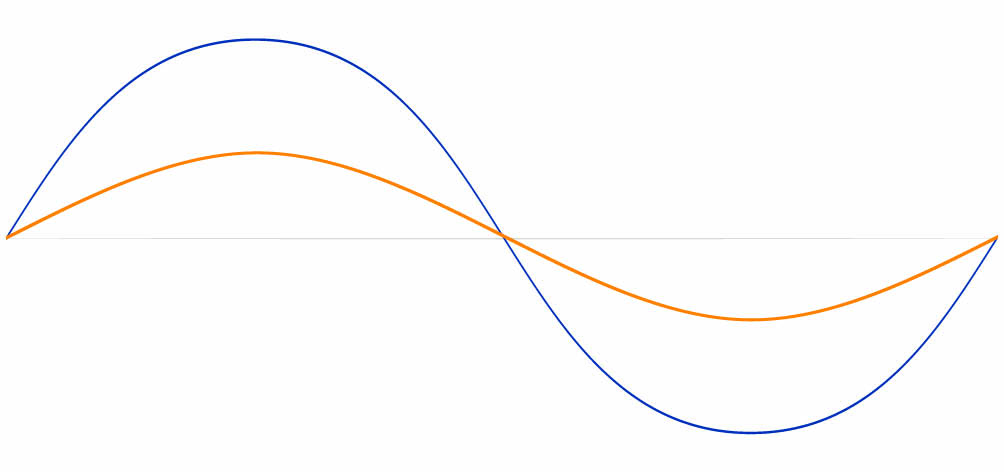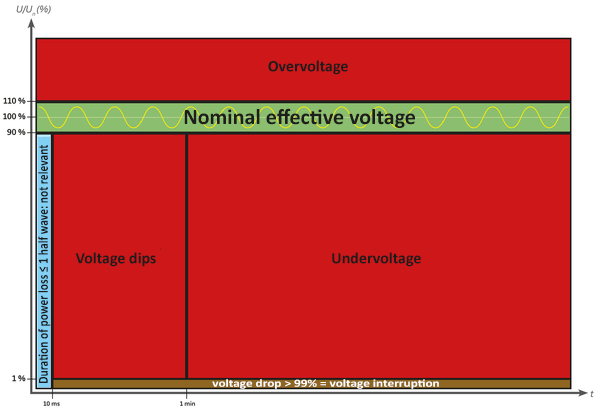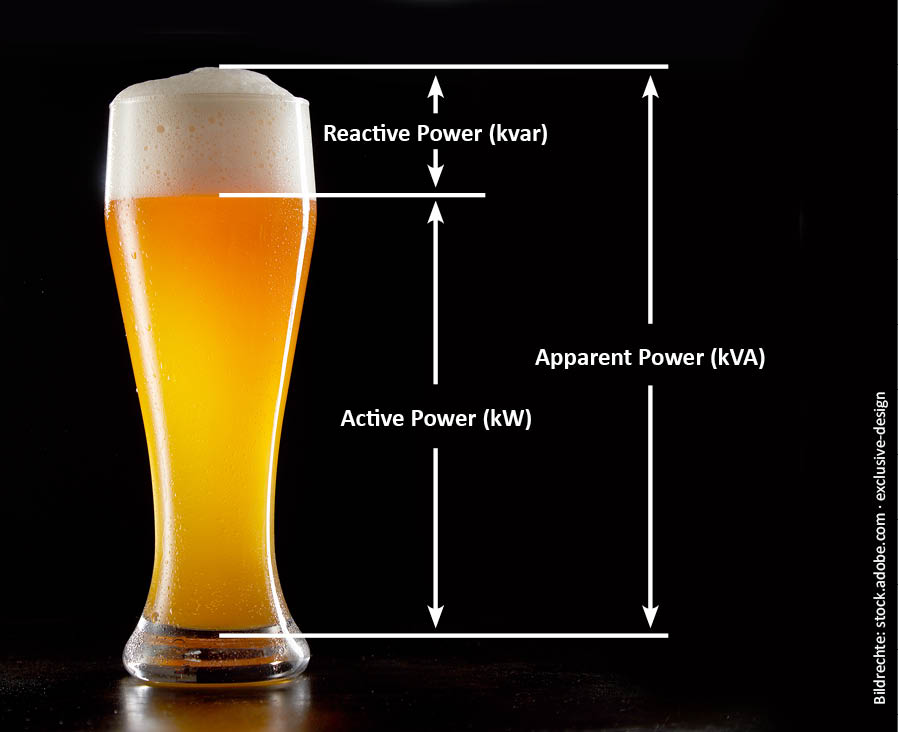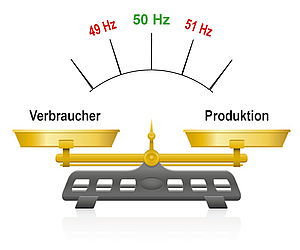Mains feedback
The voltage quality is influenced by various quantities caused by consumption and generation plants. These quantities are generally referred to as system perturbations. They occur as harmonic voltages, voltages at interharmonic frequencies, flicker, voltage changes, voltage change characteristics, voltage fluctuations affecting the sinusoidal level, and voltage unbalances. The maximum permissible compatibility levels of the individual system perturbations are regulated and standardized (among other things) in DIN EN 61000-2-4 ‘Ambient conditions – Compatibility levels for low-frequency conducted disturbance variables in industrial systems’. This standard is the resilient foundation on which we, with the help of our know-how and our structured product portfolio, provide your power supply safely and in conformity with the standard. Let this page guide you informatively from the respective network feedback or voltage phenomenon to the effective power quality tool to find our possible solution or the respective contact person.
.

Voltage conditioning
In the worldwide power supply networks, arbitrary disturbances of voltage levels occur, which lead to short-term interruptions in manufacturing processes or to long downtimes of production plants.
In norms and standards such as EN 50160 or EN 61000-2-4, the voltage limits and respectively permissible deviations are defined. In the area of ‘conditioning voltages’, these are always related to the voltage level and duration. Based on this classification, we distinguish between voltage dips, overvoltages / undervoltages, flicker and unbalances. For each of these phenomena, we have a suitable tool to constantly ensure optimum voltage, especially in your sensitive production processes.

Classification of harmonic ranges over an entire frequency band.
Because of the physical similarities between harmonics in electrical engineering and harmonics in music, we’ve tried to give some audio-visual treatment to the superposition of harmonics of a 50 Hz sine wave with this short example video. For more info, check out our Little Harmonic Theory.
Harmonics in general
Network feedback in the form of harmonics (oscillations with a multiple of the fundamental frequency) is nowadays an essential component in influencing the voltage quality. Equipment with non-linear U-I characteristics or non-stationary operating behaviour leads to the absorption of a non-sinusoidal current, which in turn leads to correspondingly non-sinusoidal voltage drops and thus to distortion of the voltage supply due to its injection against the existing mains impedance. The consequences include, among others, the destruction of equipment, interference with the correct functioning of electronic controls or the excitation of critical resonances. Although it is possible to reduce the emission of harmonics by taking suitable measures, it is not possible to eliminate them completely. IEC 61000-2-4 as a product guideline standard specifies fixed limits for the maximum permissible voltage distortion. If these limits are exceeded, equipment and processes may be disturbed without the manufacturer being held liable. In such cases, the customer must pay for the costs incurred, for example, for repairs and production downtimes. Particularly in the event of a failure of entire production processes, the costs incurred can quickly add up to many times the amount that would have been incurred if suitable measures had been taken in advance to reduce the voltage distortion causing the problem. It is therefore the customer’s responsibility to ensure that the existing voltage distortions in his network are reduced to a level compatible with the standard.
On the entire frequency band – from low-frequency to high-frequency oscillations – the different types of harmonics are divided into their physical characters. Using this classification, the distortions are separated from each other, analyzed and the best tool from our PQ toolbox is assigned to the respective disturbance phenomenon in each case.
.
- Sub-harmonic harmonics (frequencies < 50 Hz): Sub-harmonic oscillations in power systems are not an unknown phenomenon. They are natural frequencies that occur in all oscillatory systems. In the electrical supply network, they describe the change in amplitude of the voltage, influenced, for example, by load changes, voltage regulators or torsional vibrations of large machines. In the past, they have led to system limits being reached and even to costly damage being caused, mainly in the transmission network. In current power grids, sub-harmonics no longer play a role.
- Harmonic harmonics (mainly odd, natural multiples of the fundamental up to 2 kHz): Harmonics are oscillations whose frequencies are an integer multiple higher than those of the fundamental. They occur when the electrical voltage is distorted due to various influencing factors. For more info, see our Little Harmonic Theory.
- Inter-harmonic harmonics (frequencies between harmonics): Inter- or inter-harmonics are also superpositions of the 50 Hz fundamental, but whose frequencies correspond to a non-integer multiple of the fundamental frequency. Voltage distortions in these frequency ranges are often signs of an existing grid resonance.
- Supra-harmonic – high-frequency – harmonics (frequencies above 2 kHz): The amount of power electronics in our energy grids is constantly increasing – due to technological advancements. The physical sizes of the power electronics components installed today – such as circuit boards for inverters and rectifiers – are being further reduced. This makes it possible to switch current and voltage faster and in many different steps. However, this also increases occurring voltage phenomena that, especially in the high-frequency / superharmonic frequency range (> 2 kHz), energy, supply and industrial networks as well as regenerative energy parks, immensely burden.

Compensating reactive power - in brief
Reactive power is generated by inductive and capacitive equipment in the power grid. In inductive loads, such as motors, the windings generate a magnetic field in each sinusoidal half-cycle. In capacitive equipment, such as cables, an electric field is generated. Current is required for these processes, which is stored as energy in the field and released again when the half-oscillation changes. This results in a phase shift and the current oscillates between load and generation without being consumed (apart from line losses). This so-called reactive current must therefore be provided by the energy supplier and generates costs. From an economic point of view, it makes sense for companies with a certain amount of purchased reactive power to compensate for this on-site at the load in order to save costs.
.
Frequency interferences
The power from the socket is not always of the same quality. Users of electrical appliances do not normally notice this. For him, there are only two states: power on or power off, i.e. power failure. But with a measuring device, the power quality can be easily detected. It is revealed by the frequency of the alternating voltage. Normally, the electric voltage changes its direction with a frequency of 50 hertz. The temporal change of the voltage level corresponds to a well-formed sine curve. All over Germany, indeed all over Europe – at least in the European UCTE interconnected grid – all power plants, overhead power lines and electrical devices work nicely synchronized in time with just these 50 Hertz (America = 60 Hertz), at least theoretically. In practice, the grid frequency is not completely stable, but fluctuates a bit. These slight variations do not affect the quality of the power. What happens is that generation and load are not equal.
If the generated power > consumed power = overfrequency.
If generated power < consumed power = underfrequency.
Transmission system operators are responsible for the system service of frequency maintenance. Their task is to keep power generation and consumption exactly in balance at all times, thus ensuring the indispensable prerequisite of stable grid operation.
Comment by Managing Director Dr. Dresel on the often-discussed subject of blackouts: “Even in the event of a possible gas shortage in power plants, a complete blackout of our Europe-wide energy network is very unlikely. Before this worst-case scenario occurs, the transmission system operators stabilize the entire grid with the help of a load shedding 5-stage plan and regulated grid disconnections. It should be mentioned that grid disconnections and load shedding in our EU interconnected grid were only really noticeably acute on two occasions. But even in this situation, we were far from a blackout.”
